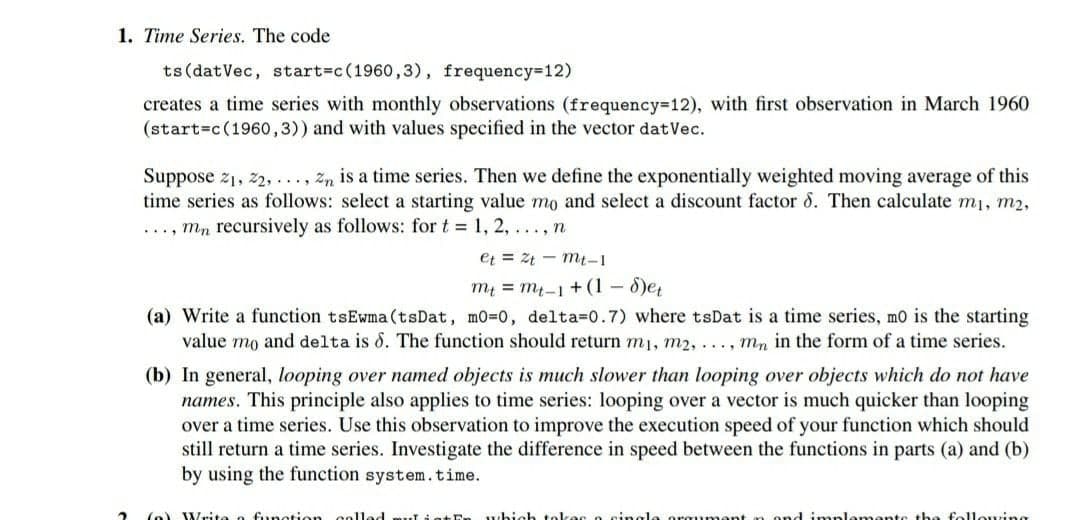Time Series. The code ts (datVec, start%=c(1960,3), frequency-12) creates a time series with monthly observations (frequency-12), with first observation in March 1960 (start%3Dc(1960,3)) and with values specified in the vector datVec. Suppose z1, 22,..., zn is a time series. Then we define the exponentially weighted moving average of this time series as follows: select a starting value mo and select a discount factor 8. Then calculate m1, m2, ..., mn recursively as follows: for t = 1, 2, ...,n et = zt - mt-1 m = m-1 +(1 – 8)e (a) Write a function tsEwma (tsDat, mo=0, delta=0.7) where tsDat is a time series, mo is the starting value mo and delta is 6. The function should return m1, m2,..., m, in the form of a time series. %3D (b) In general, looping over named objects is much slower than looping over objects which do not have names. This principle also applies to time series: looping over a vector is much quicker than looping over a time series. Use this observation to improve the execution speed of your function which should still return a time series. Investigate the difference in speed between the functions in parts (a) and (b) by using the function system.time.
Time Series. The code ts (datVec, start%=c(1960,3), frequency-12) creates a time series with monthly observations (frequency-12), with first observation in March 1960 (start%3Dc(1960,3)) and with values specified in the vector datVec. Suppose z1, 22,..., zn is a time series. Then we define the exponentially weighted moving average of this time series as follows: select a starting value mo and select a discount factor 8. Then calculate m1, m2, ..., mn recursively as follows: for t = 1, 2, ...,n et = zt - mt-1 m = m-1 +(1 – 8)e (a) Write a function tsEwma (tsDat, mo=0, delta=0.7) where tsDat is a time series, mo is the starting value mo and delta is 6. The function should return m1, m2,..., m, in the form of a time series. %3D (b) In general, looping over named objects is much slower than looping over objects which do not have names. This principle also applies to time series: looping over a vector is much quicker than looping over a time series. Use this observation to improve the execution speed of your function which should still return a time series. Investigate the difference in speed between the functions in parts (a) and (b) by using the function system.time.
Computer Networking: A Top-Down Approach (7th Edition)
7th Edition
ISBN:9780133594140
Author:James Kurose, Keith Ross
Publisher:James Kurose, Keith Ross
Chapter1: Computer Networks And The Internet
Section: Chapter Questions
Problem R1RQ: What is the difference between a host and an end system? List several different types of end...
Related questions
Question

Transcribed Image Text:1. Time Series. The code
ts (datVec, start=c(1960,3), frequency-12)
creates a time series with monthly observations (frequency=12), with first observation in March 1960
(start=c(1960o,3)) and with values specified in the vector datVec.
Suppose z1, 22, ..., zn is a time series. Then we define the exponentially weighted moving average of this
time series as follows: select a starting value mo and select a discount factor 8. Then calculate m1, m2,
..., mn recursively as follows: for t = 1, 2, ..., n
et = Zt - mt-1
my = m-1 + (1– 8)e
(a) Write a function tsEwma(tsDat, mo=0, delta=0.7) where tsDat is a time series, mo is the starting
value mo and delta is 8. The function should return m1, m2,..., mn in the form of a time series.
(b) In general, looping over named objects is much slower than looping over objects which do not have
names. This principle also applies to time series: looping over a vector is much quicker than looping
over a time series. Use this observation to improve the execution speed of your function which should
still return a time series. Investigate the difference in speed between the functions in parts (a) and (b)
by using the function system.time.
(o) Write a fungtion colled
which tol
mante the following
Expert Solution
This question has been solved!
Explore an expertly crafted, step-by-step solution for a thorough understanding of key concepts.
This is a popular solution!
Trending now
This is a popular solution!
Step by step
Solved in 4 steps with 2 images

Recommended textbooks for you

Computer Networking: A Top-Down Approach (7th Edi…
Computer Engineering
ISBN:
9780133594140
Author:
James Kurose, Keith Ross
Publisher:
PEARSON

Computer Organization and Design MIPS Edition, Fi…
Computer Engineering
ISBN:
9780124077263
Author:
David A. Patterson, John L. Hennessy
Publisher:
Elsevier Science

Network+ Guide to Networks (MindTap Course List)
Computer Engineering
ISBN:
9781337569330
Author:
Jill West, Tamara Dean, Jean Andrews
Publisher:
Cengage Learning

Computer Networking: A Top-Down Approach (7th Edi…
Computer Engineering
ISBN:
9780133594140
Author:
James Kurose, Keith Ross
Publisher:
PEARSON

Computer Organization and Design MIPS Edition, Fi…
Computer Engineering
ISBN:
9780124077263
Author:
David A. Patterson, John L. Hennessy
Publisher:
Elsevier Science

Network+ Guide to Networks (MindTap Course List)
Computer Engineering
ISBN:
9781337569330
Author:
Jill West, Tamara Dean, Jean Andrews
Publisher:
Cengage Learning

Concepts of Database Management
Computer Engineering
ISBN:
9781337093422
Author:
Joy L. Starks, Philip J. Pratt, Mary Z. Last
Publisher:
Cengage Learning

Prelude to Programming
Computer Engineering
ISBN:
9780133750423
Author:
VENIT, Stewart
Publisher:
Pearson Education

Sc Business Data Communications and Networking, T…
Computer Engineering
ISBN:
9781119368830
Author:
FITZGERALD
Publisher:
WILEY